Moroccan Bastilla is the starting point for an adventure to discover the joy of learning and how to make traditional Bastilla. This delicious pastry is beloved in Morocco for its wonderful taste that combines salty and sweet. It contains layers of crispy filo dough and a rich, fragrant filling. Bastille is not just a dish but a story about Moroccan culture and its great culinary history. Known as Bastilla or Bastilla, it is a star on special occasions. It showcases Moroccan cooking skills and creativity. Whether you are a seasoned chef or new to the kitchen, learning about Bastilla will open up a world of different flavors and a special challenge for you.
Table of Contents
Key Takeaways
- Discover the rich history and cultural significance of the traditional Moroccan Bastilla.
- Discover the key ingredients and methods for preparing authentic Bastilla fillings.
- Learn to master filo dough and expertly assemble the perfect Bastilla
- Discover the variations and secrets to mastering this Moroccan culinary treasure.
- Avoid common mistakes and ensure your Bastilla will be a smashing success.
Understanding the Rich History of Moroccan Bastilla
Moroccan Bastilla has deep roots in the culinary traditions of Andalusia. This region connected the Iberian Peninsula and North Africa. Over time, this delicious pastry has become an essential part of Moroccan food culture.
Origins and Cultural Significance
The industry began in Fez in Morocco, a city that dates back twelve centuries. This dish was a favorite in this city at weddings and major celebrations. Its appearance suggests luxury, and its layers of thin dough, spices, and fillings create a mixture of Maghrebi, Iberian, and African flavors in Moroccan food.
Evolution of Traditional Recipes
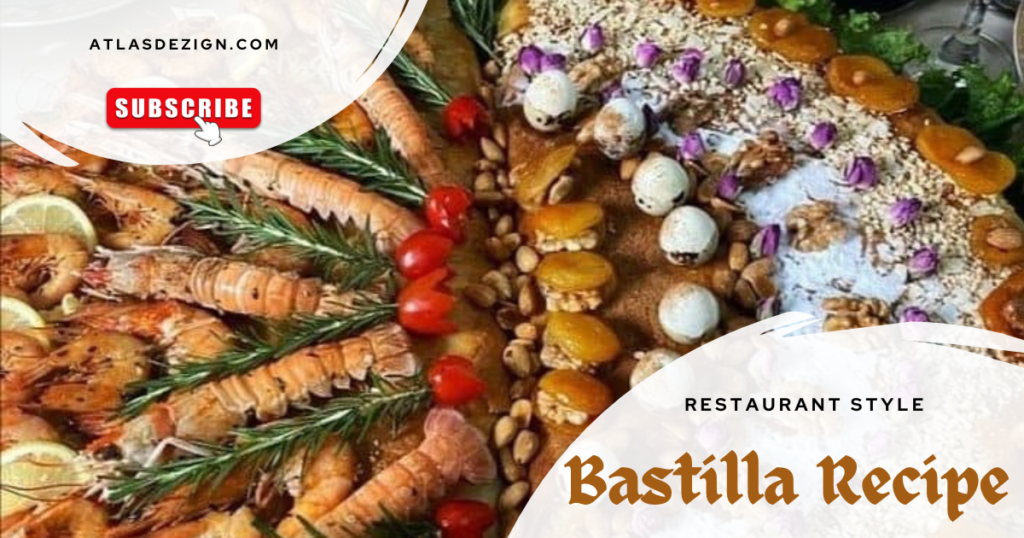
Over the years, the Bastilla recipe has evolved, incorporating various changes and adaptations.
. Each part of Morocco has its way of preparing this dish, and now, you can find several variations of this dish such as Bastilla with beef, seafood, or even vegetables, making it a versatile dish that suits all tastes.
Regional Variations Across Morocco
- In Fez, the bastilla is famous for its sweet and savory mix. It often includes almonds, cinnamon, and a bit of sugar.
- Coastal areas like Essaouira and Casablanca offer seafood-filled bastillas. They highlight the fresh catches from the Atlantic.
- The southern oases, such as Ouarzazate and Zagora, focus on local spices and seasonal foods. They show the desert’s unique flavors.
Despite differences, the bastilla is a beloved part of Moroccan culture. It’s a tasty symbol of the country’s rich history and diverse food scene.
Essential Ingredients for Authentic Bastilla
Preparing Moroccan Bastilla requires a combination of special ingredients. Its essence lies in the filling, a mixture of flavors in the filo dough. Whether you are a professional in the kitchen or a beginner in cooking, knowing the main ingredients is essential in preparing this distinctive dish.
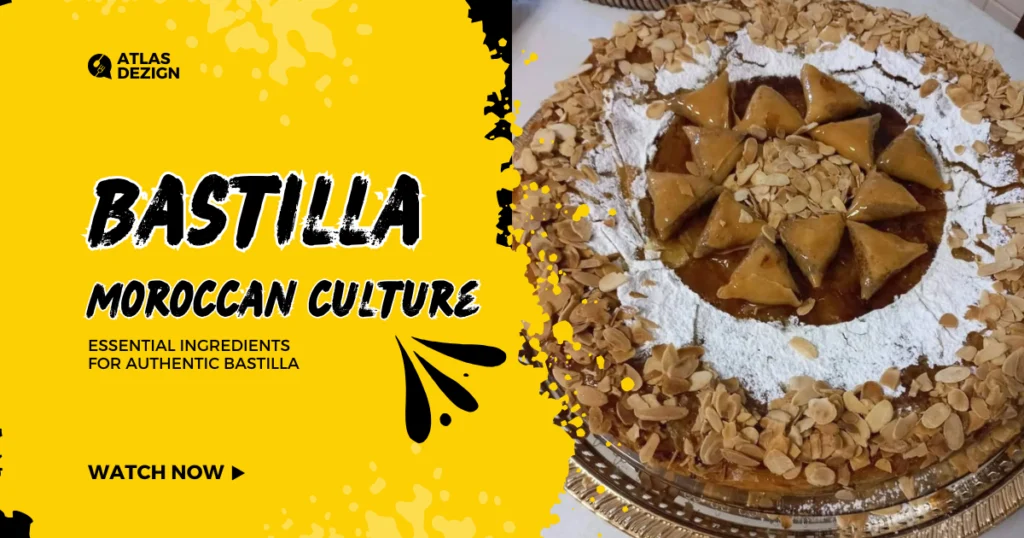
Poultry: The Backbone of Bastilla
The heart of the Bastilla filling is made up of several ingredients, such as chicken, pigeon, or fish. To get a distinctive chicken dish, you must choose high-quality birds from free-range birds to get the best taste. This ensures that the meat is tender and full of Moroccan flavor.
Spice Blend: The Essence of Moroccan Flavors
The filling comes alive with a mix of spices. Saffron, cinnamon, ginger, and white pepper add depth and allure. Together, they create a unique and captivating taste.
Phyllo Dough: The Crisp Exterior
The filo dough is the key to a good bastilla. It is thin and flaky, which contrasts with the rich filling. Using high-quality filo is essential to get the right texture. Knowing the ingredients of a traditional Moroccan bastilla is the first step to mastering it. From the meat to the spices and the dough, every part counts. They all work together to create a dish that is loved by many.
| Ingredient | Role in Bastilla |
| Chicken or Pigeon | Provides the protein and foundation for the filling |
| Saffron, Cinnamon, Ginger, White Pepper | Contributes to the unique Moroccan flavor profile |
| Phyllo Dough | Creates the crisp, flaky exterior of the Bastilla |
Mastering the ingredients for authentic bastilla is the first step to making Moroccan flavors at home. Whether you’re making Bastilla for the first time or improving your skills, knowing each part’s role is key to getting it right.
Mastering the Art of Bastilla Filling Preparation
Making a real Moroccan bastilla needs careful attention to the filling. Choosing the right poultry and blending spices are key. Each step is important for the dish’s unique flavors. Let’s uncover the secrets to making the Bastilla filling that will impress your guests.
Selecting and Preparing the Poultry
The heart of the pastilla filling is poultry. Traditionally, chicken and pigeon are used, but you can experiment with other types of meat. Choose high-quality, outdoor poultry for the best flavor. Brown the meat to create a delicious crust, then cook it over low heat until it is tender and easy to cut.
Perfecting the Spice Blend
The spice blend is what makes the bastilla special. Use saffron, cinnamon, ginger, and white pepper for the best flavor. Try different mixes and adjust the amounts to your liking. Toasting the spices before grinding them will make your Bastilla even more authentic.
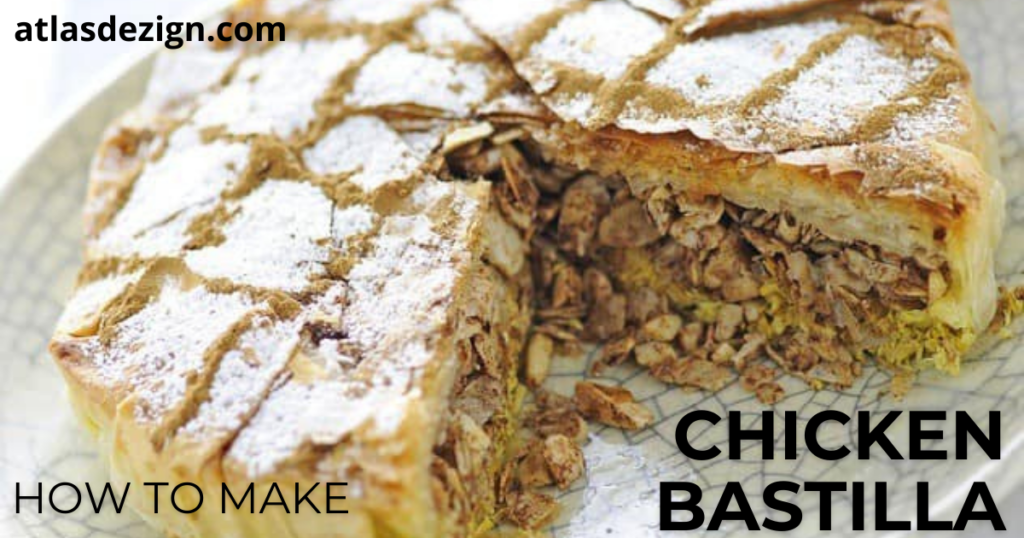
Creating the Egg Mixture
The egg mixture holds the filling together, making it smooth and cohesive. Mix eggs, almond flour, and a bit of sugar for a custard-like texture. This mixture not only keeps the filling together but also adds a sweet touch that balances the savory flavors.
By mastering the Bastilla filling, you’ll reveal the true essence of this Moroccan dish. From choosing the poultry to blending the spices and making the egg mixture, each step is vital. These steps will help you create a Bastilla that will impress your guests.
Working with Phyllo Dough: Tips and Techniques
Learning to work with phyllo dough is key to making a great Moroccan Bastilla. This thin pastry can be hard to handle, but with the right methods, you can get it just right. Let’s look at the secrets to making Bastilla with phyllo dough.
Handling Phyllo Dough with Care
Phyllo dough is very delicate. It’s important to handle it carefully. Keep it covered with a damp cloth or plastic wrap to stop it from drying out. Work fast, as it dries out quickly.
Layering and Brushing Techniques
When making your Bastilla, layer the phyllo dough carefully. Brush each sheet with melted butter or oil. This makes the dough flaky and helps it not to tear. Work with one sheet at a time, keeping the others covered.
Preventing Tears and Ensuring Crispiness
To avoid tears and get a crispy crust, follow these tips:
- Gently unfold the phyllo sheets and handle them with a light touch to avoid rips or holes.
- Brush each layer generously with melted butter or oil, ensuring even coverage.
- Bake the bastilla at a high temperature (around 400°F/200°C) to help the phyllo dough achieve a perfect crispness.
Storing and Thawing Phyllo Dough
If you’re using frozen phyllo dough, thaw it in the fridge overnight. This slow thawing prevents it from becoming brittle. Store leftover phyllo dough in the freezer, tightly wrapped, for later use.
| Tip | Description |
| Handling Phyllo Dough | Keep dough covered with a damp cloth or plastic wrap to prevent drying and cracking. |
| Layering and Brushing | Carefully layer phyllo sheets, brushing each with melted butter or oil to prevent tearing. |
| Preventing Tears | Handle phyllo sheets with a light touch and bake at high temperature for a crisp crust. |
| Storing and Thawing | Handle phyllo sheets with a light touch and bake at a high temperature for a crisp crust. |
By mastering the techniques of working with filo dough, you will be on your way to making the perfect bastilla and discovering the secrets of preparing bastilla. With a little practice and patience, you can achieve the golden brown crust that makes Moroccan bastilla a true delight in the kitchen.
Step-by-Step Guide to Assembling Your Bastilla
Learning how to make Moroccan Bastilla is a journey. We will try to make you happy by becoming a pro at making this delicious dish. We will show you how to layer, fold, and add the finishing touches to the Bastilla method.
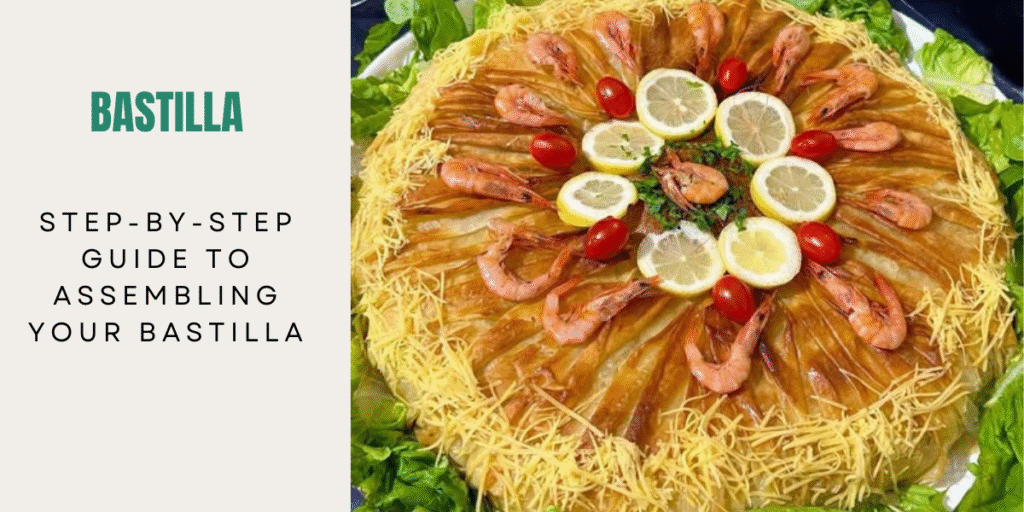
Layering Techniques
The secret to making flaky, balanced Moroccan Bastilla lies in the layers. Grease the bottom of a baking dish with butter or olive oil. Place a sheet of filo pastry, leaving the edges hanging down.
Repeat this for 5-7 layers of filo, brushing each layer with butter or oil.
Proper Folding Methods
- Put the filling in the center of the phyllo, leaving space around the edges.
- Fold the dough over the filling to make a neat package.
- Brush the edges with butter or oil to seal it.
Decorative Finishing Touches
- Brush the top with a beaten egg yolk for a golden crust.
- Lightly dust with powdered sugar or cinnamon for sweetness.
- Add slivered almonds or sesame seeds for a decorative touch.
By following these steps, you’ll make a how-to make bastilla that’s both delicious and beautiful. Share your homemade Moroccan bastilla with loved ones. Enjoy the rich flavors of this traditional dish.
Common Mistakes to Avoid When Making Bastilla
Making Bastilla, a traditional Moroccan dish, can be a fun journey. But it’s easy to make mistakes. Knowing these common errors will help you make a delicious bastilla.
One big mistake is overcooking the filling. Make sure to watch the timing and temperature when cooking the poultry and egg mix. Also, don’t skip the spice blend. The right mix of spices is key to a great flavor.
Another mistake is a soggy or brittle phyllo dough crust. It’s important to handle and layer the dough right. This will give you a flaky, golden crust.
Some people also struggle with folding the dough. This can make your bastilla look messy. Practice folding to make sure your dish looks as good as it tastes.
By avoiding these mistakes, you can make a fantastic Bastilla. It will be a hit with your friends and family.
Conclusion
Congratulations on mastering the Moroccan Bastilla! You’ve learned about its history, key ingredients, and how to make it. Now, you can make a bastilla that would impress anyone.
Keep exploring Moroccan food and its rich flavors and traditions. Serve your Bastilla with mint tea, fresh veggies, and almonds for a real Moroccan meal. You’re on your way to becoming a Moroccan bastilla expert.
Cooking is about more than just making food. It’s about the journey and creativity. So, try new things, adapt recipes, and make them your own. Bon appétit, and may your kitchen always smell of Moroccan delights!
There are still other secrets to this dish that we will provide you with in other articles. We hope that the article has added something new to you.
FAQ
What is Moroccan Bastilla?
Moroccan Bastilla is a savory pie with a mix of flavors and textures. It has a flaky phyllo dough crust. Inside, you’ll find juicy poultry, scrambled eggs, and a strong spice blend.
What is the cultural significance of Bastilla in Moroccan cuisine?
Bastilla is a beloved dish in Moroccan culture. It’s often served at big celebrations and weddings. This shows its importance and value in Moroccan cuisine.
What are the essential ingredients for an authentic Moroccan Bastilla?
To make traditional Bastilla, you need phyllo dough, chicken or pigeon, eggs, onions, almonds, saffron, cinnamon, and spices. These ingredients mix to create the dish’s unique taste.
How do you prepare the Bastilla filling?
Making the filling involves a few steps. First, cook the poultry. Then, mix a flavorful spice blend. Scramble the eggs and combine them with the cooked poultry and spices.
What are the best techniques for working with phyllo dough for Bastilla?
Working with phyllo dough needs care. Layer the sheets carefully, brush with butter or oil, and avoid tears. Storing and thawing the dough correctly is also important for a crispy texture.
How do you assemble and bake the perfect Bastilla?
To assemble Bastilla, layer the phyllo dough and filling carefully. Fold the dough to shape it. Pay attention to detail for a great presentation.
What are some common mistakes to avoid when making Bastilla?
Avoid overcooking the filling to prevent dryness. Also, be careful with the phyllo dough to avoid tears or a soggy crust. Keeping the right temperature and using the right techniques are key.


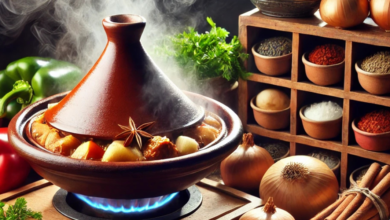 Moroccan Tajine : discover the secrets of its preparation and its origins that date back centuries
Moroccan Tajine : discover the secrets of its preparation and its origins that date back centuries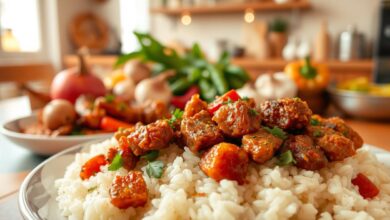 How to make rice with meat recipe in an easy and distinctive way
How to make rice with meat recipe in an easy and distinctive way Moroccan Couscous Recipe: The Secret to Authentic Flavor and Ancient Tradition
Moroccan Couscous Recipe: The Secret to Authentic Flavor and Ancient Tradition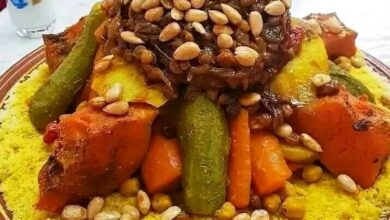 9- Moroccan couscous, its secrets and amazing health benefits
9- Moroccan couscous, its secrets and amazing health benefits